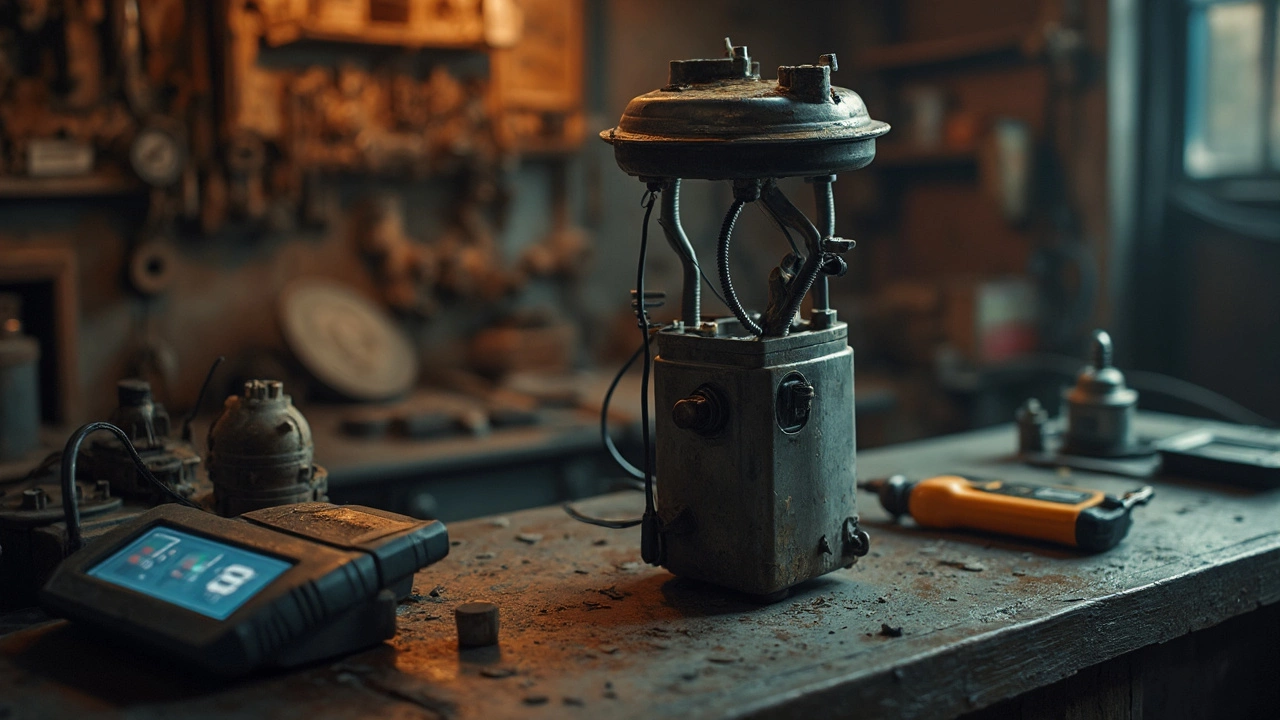 May, 6 2025
May, 6 2025
Your car won’t get far without a working fuel pump, but what if it’s going bad—can it still turn on? This is exactly the headache that trips up a lot of folks, me included. A fuel pump can get dodgy way before it quits for good. Sometimes, it’ll still hum to life when you turn the key, even if it’s barely doing its job.
So, don’t trust the sound alone. Just because you can hear the pump whirring doesn’t mean it’s pushing enough fuel. You might get rough starts, sputtering, or random stalls. One day your car fires up fine, the next it acts like it skipped breakfast. It’s not always black and white; a dying fuel pump often has one foot in the grave but can trick you into thinking it’s fine. Knowing these early warnings (and not just listening for a noise) can save you money and stress later on.
- How a Fuel Pump Works
- Common Signs of a Bad Fuel Pump
- Can a Failing Fuel Pump Still Activate?
- Troubleshooting Tips and Tests
- What to Do Next and Prevention
How a Fuel Pump Works
Your car’s engine needs fuel, but it can’t just sip from the tank by itself. That’s where the fuel pump comes in. Its main job is to pull fuel from the gas tank and push it up to the engine—no pump, no go. For most cars today, we’re talking about an electric fuel pump tucked right inside the tank, while older rides might have a mechanical pump closer to the engine.
When you turn the key, the fuel pump gets a zap of power and starts moving fuel. Electric pumps use a small motor that spins fast, creating the pressure your fuel injectors need. That pressure is everything: fuel injectors won’t open or deliver the right amount of gas otherwise. Most pumps pressurize gas between 40 and 60 PSI (pounds per square inch). If that drops, you get weak performance, rough idling, or a car that won’t start.
Here’s a look at the basic steps:
- You turn the ignition key or press start.
- The car’s ECU (the computer) signals the fuel pump relay.
- Power flows to the fuel pump.
- Pump draws fuel up from the tank.
- Fuel is pushed through a filter and sent to the engine.
On some cars, you’ll actually hear the pump whir for a second when you flip the key before starting the engine. That little buzz is the pump priming the system so your engine fires right up.
| Part | What It Does |
|---|---|
| Fuel Pump | Draws and pushes fuel to engine |
| Fuel Filter | Keeps dirt and grime out of fuel |
| Fuel Rail | Distributes fuel to injectors |
| Injectors | Spray fuel into the engine at high pressure |
No matter what car you drive, a healthy fuel pump keeps gas moving—and your engine running smooth. It’s simple on the surface, but when a pump starts to go, so does everything fuel-related in your ride.
Common Signs of a Bad Fuel Pump
A bad fuel pump doesn’t always stop working right away—it usually gives little hints before it dies for good. Most drivers notice clues, but a lot of them ignore these early warning signs. Knowing what to watch for can spare you a lot of hassle, high repair bills, or sitting stranded on the shoulder.
- Engine Sputtering or Jerking: If your car jerks or sputters at high speeds, your fuel pump might not be delivering enough pressure. It feels like the engine’s coughing for fuel, especially when you hit the gas hard.
- Hard Starting: You turn the key, but your car takes forever to catch, or it might not start at all. A bad fuel pump can’t always push enough gasoline fast enough, leading to those annoying long cranks.
- Sudden Loss of Power: If you’re climbing a hill, speeding up, or putting extra load on the engine and suddenly it loses power, think fuel delivery problems.
- Stalling for No Reason: One minute you’re driving, the next your engine just gives up—especially at higher temps. It’s a classic red flag.
- Noisy Pump: Usually, your fuel pump should make a soft whirring sound you barely hear. If it suddenly sounds like it's whining or buzzing loudly, that’s bad news. Sometimes, it’s the only clue you’ll get before total failure.
Here’s something that surprises a lot of people: about 80% of fuel pump problems start with inconsistent power delivery—not a dead pump. Check out this quick comparison table of key symptoms...
| Symptom | Possible Cause | What You Feel/See |
|---|---|---|
| Engine Sputtering | Low Fuel Pressure | Jerks/hesitates at speed |
| Long Crank/No Start | Weak Fuel Pump | Engine slow to start |
| Loss of Power | Flow Interruption | Stalls under load |
| Loud Pump Noise | Wear or Contamination | Obvious whining/buzzing |
If you catch these signs early, you can avoid the headache of being stuck alongside the road. The trick is not to brush off small hiccups—when your car talks, listen. Swap out the fuel pump before it leaves you stranded.

Can a Failing Fuel Pump Still Activate?
Here’s the tricky thing about a bad fuel pump: it doesn’t have to completely shut down to mess up your day. In a lot of cases, a failing fuel pump can still turn on—it might even sound normal for a few seconds. That doesn’t mean it’s healthy though. If your pump is weak or worn, it might get just enough juice to spin up, but not enough to deliver proper fuel pressure to your engine. Think of it like a runner with a twisted ankle—technically still moving, but not about to win any races.
What does this mean for your car? You could hear the usual whirr from the tank when turning the key, but still have trouble starting, rough idling, stalling, or poor acceleration. Vehicles often show intermittent issues when this happens. A fuel pump with dying electronics or worn-out motors could work fine one minute, then cut out the next—especially when under stress, like after a long drive or on hot days.
Some vehicles show a "Check Engine" light or store codes related to the fuel system (like P0230 or P0087). You might notice that after sitting a while, your car starts fine, but if you drive for an hour and stop to get gas, it won’t restart easily. That’s because pumps often fail worse when hot, thanks to expanding metal and tired wiring.
Signs that a failing pump is still partially working include:
- The engine turns over, but takes longer to start
- Starts and runs, but sputters under load or at high speeds
- You hear pump noise, but power drops on hills or highway
- The car stalls and then will restart again after cooling off
Here’s a straightforward table to show how a bad fuel pump may act compared to one that’s totally fried:
| Fuel Pump State | Activates? | Symptoms |
|---|---|---|
| Healthy | Yes | No trouble starting, smooth ride |
| Failing | Yes (sometimes) | Rough starts, occasional stalls, low power |
| Completely Dead | No | No start, no noise, stranded |
So if your fuel pump is on the way out, don’t think you’re in the clear just because you hear it click on. Sometimes it’s the half-working ones that cause the most head-scratching before finally giving up for good.
Troubleshooting Tips and Tests
So you suspect your fuel pump just isn’t cutting it. How do you make sure it’s the bad fuel pump and not something else? You don’t want to waste cash swapping out parts for no reason. Start with some easy checks before pulling the trigger on a replacement.
First off, listen for that classic fuel pump hum when you turn your key to “on” (don’t crank it, just to ON). No hum? That could mean total failure, blown fuse, or a relay problem. Catch a weak, irregular sound? Often, that’s a dying fuel pump—but not always.
Next up, check fuel pressure. Buy or borrow a fuel pressure gauge for your car’s rail. Match the reading to the factory specs (can usually find it on a sticker under the hood or in your manual). Here’s what typical numbers look like:
| Vehicle Type | Normal Fuel Pressure (PSI) |
|---|---|
| Modern Fuel Injected | 45–60 |
| Older Carbureted | 4–7 |
If you see lower than normal pressure, your fuel system could be the issue—sometimes a failing pump, sometimes a clogged filter.
Don’t forget quick checks on related stuff. Look at the fuel pump fuse and relay. Swap relays if you can. Some cars let you "thump test" the tank—give it a solid hit and see if the fuel pump wakes up for one last spin. (Not exactly scientific, but it works sometimes.)
- Car struggles to start? Pump might intermittently fail.
- Random stalls? That’s textbook failing fuel delivery problems.
- Loss of power under load? Pump might be dying under stress.
Fuel pump problems can sometimes cause engine codes. Scan for codes like P0230–P0232 (pump circuit problems) or P0087 (low fuel rail pressure).
“A weak pump may run and prime, but only deliver just enough fuel for idle, resulting in poor acceleration or stalling at higher speeds.” – Popular Mechanics
Be careful before blaming the pump though—mass air flow sensors, filters, and even bad gas can create similar drama. If you want to be sure, pull the pump and bench test it with a simple 12V source. It should move fuel at a steady, strong rate. Anything less, and you’ve found your problem part.
These checks usually cover the basics, and most drivers can handle them without a garage full of tools. If you’re still not sure, a pro mechanic can pressure test and diagnose more deeply.

What to Do Next and Prevention
If your bad fuel pump is giving you warning signs or on-again, off-again issues, don't wait for it to strand you. Addressing the problem early makes life easier—and cheaper. Here’s how you can keep things from getting worse and prevent headaches down the road.
- Confirm the problem: Use a fuel pressure gauge to check if the pump is delivering enough juice. Compare your numbers with the specs from your car’s manual. Low or no pressure usually points to a bad pump or clogged filter.
- Check for trouble codes: A cheap OBD-II scanner can pick up on codes related to fuel delivery problems. Even if you don’t see a check engine light, codes like P0230 or P0231 tell you there’s something up with the pump circuit.
- Replace as needed: If you confirm the fuel pump symptoms, replace it. Most people can do this at home with basic tools. Just be ready to work around gas and take the right safety steps—wear gloves, disconnect the battery, and so on.
To avoid problems with your fuel system, a little routine care goes a long way. Here’s what I mean:
- Don’t run your tank near empty often. Fuel keeps the pump cool—run dry too many times and you’ll wear out the pump early.
- Change your fuel filter based on your car’s service schedule, or sooner if you use questionable gas. A clogged filter makes your fuel pump work overtime.
- If your pump is original and you’re over 100,000 miles, keep an ear out for new sounds or changes.
If you’re not sure whether it’s safe to drive, play it safe—get a tow instead of risking a roadside breakdown. And remember, aftermarket fuel pumps don’t cost a fortune, but the tow and time wasted sure do.
If you’re curious how common fuel delivery problems are, check this out:
| Cause | % of Fuel System Failures |
|---|---|
| Clogged fuel filter | 34% |
| Bad fuel pump | 52% |
| Wiring/Relay issues | 9% |
| Other | 5% |
Stay ahead of issues and save yourself the hassle—proactive checks are your best friend here.